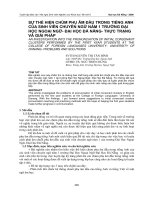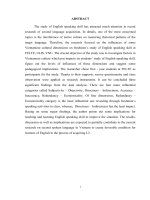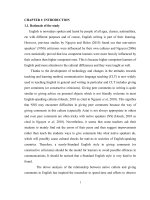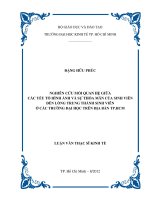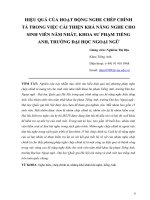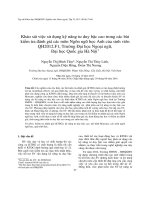ẢNH HƯỞNG của một vài yếu tố văn hóa VIỆT NAM đến NHẬN xét CHÉO TRONG môn VIẾT của SINH VIÊN năm NHẤT TRƯỜNG đại học NGOẠI NGỮ ĐHQGHN
Bạn đang xem bản rút gọn của tài liệu. Xem và tải ngay bản đầy đủ của tài liệu tại đây (466.66 KB, 54 trang )
CHAPTER 1: INTRODUCTION
1.1. Rationale of the study
English is nowadays spoken and learnt by people of all ages, classes, nationalities,
etc with different purposes and of course, English writing is part of their learning.
However, previous studies by Nguyen and Helen (2010) found out that non-native
speakers’ (NNS) criticisms were influenced by their own cultures and Nguyen (2006)
even statistically proved that less competent learners were more heavily influenced by
their cultures than higher competent ones. This is because higher competent learners of
English paid more attention to the cultural differences and they were taught as well.
Thanks to the development of technology and changes in the attitudes towards
teaching and learning method, communicative language teaching (CLT) is now widely
used in teaching English in general and writing in particular and CLT includes giving
peer comments (or constructive criticisms). Giving peer comments in writing is quite
similar to giving advice on personal objects which is not friendly welcome in most
English-speaking cultures (Houck, 2010 as cited in Nguyen et al, 2010). This signifies
that NNS may encounter difficulties in giving peer comments because the way of
giving comments in this culture (especially Asia) is not always appropriate in others
and even peer comments are often tricky with native speakers (NS) (Houck, 2010 as
cited in Nguyen et al, 2010). Nevertheless, it seems that some teachers ask their
students to mainly find out the errors of their peers and then suggest improvements
rather than teach the students ways to give comments like what native speakers do,
which will possibly cause cultural shocks for natives in societies of English-speaking
countries. Therefore, a nearly-Standard English style in giving comments (or
constructive criticisms) should be the model for learners to avoid possible offences in
communications. It should be noticed that a Standard English style is very hard to be
found.
The above analysis of the relationship between native culture and giving
comments in English has inspired the researcher to spend time and efforts to observe
1
the peer comments in writing skill of freshmen at ULIS-VNU. It can be said that
freshmen’s peer comments are still influenced by native culture and to some extent
peer comments are not appropriate in the English-speaking cultures. In this thesis, the
researcher will discuss the influence of some Vietnamese cultural factors on peer
comments of freshmen and basing on this, the pedagogical implications in teaching
students to give comments will be suggested to help teachers raise their students’
awareness.
1.2. Aims of the study
The study was undertaken in order to evaluate the influence of Vietnamese culture
on the peer comments of freshmen. The specific objectives of the study are:
- to evaluate the influence of Vietnamese culture on peer comments of freshmen
- to suggest some ways that lecturers can use to help their students deal with this
language transference.
In addition, the aims of the study are also specified in the research questions.
1.3. The research questions
The research questions that the study addressed are:
Research question 1: What are typical ways of giving peer comments of freshmen at
VNU-ULIS?
Research question 2: What are typical ways of giving comments of English native
speakers?
Research question 3: What are similarities and differences of commenting between
freshmen and English native speakers?
Research question 4: What are the Vietnamese cultural factors which have influence
on peer comments of freshmen at VNU-ULIS?
1.4. Significance of the study
The significance of the study is evaluated by its practicality because the study
contributes partial help for both lecturers and students at Division 1, the FELTE, ULISVNU.
2
As for students, they may adapt their ways of giving comments on their peers’
assignments, which helps their comments sound more polite, avoid potential offence
and encourage their peers to better their assignments. In addition, after graduating from
university, if students have the chance to work with English native speakers, the
suggested ways of giving comments may be useful for them in their working
environment.
As for lecturers, they may reconsider the degree of the influence of some
Vietnamese cultural factors on peer comments of their students. The researcher hopes
that the lecturers will pay attention to teach their students to give comments like what
native speakers actually do in writing. In fact, freshmen are not taught the detailed way
to give comments with appropriate choice of words and expressions, which may make
their comments less effective.
1.5. Scope of the study
Due to limitation of time, knowledge and materials, the researcher only focused on
some Vietnamese cultural factors having influence on peer comments by freshmen and
suggesting some ways to help lecturers deal with this negative language transfer. The
researcher will analyze comments by freshmen on their peers’ essays and exploit
interviews with both students and lecturers.
1.6. Organization of the study
As can be seen, apart from chapter 1 which gives readers an overview of the study,
there are four other main parts.
Chapter 2 is the theoretical background which reviews some concepts used in the
present study: culture and language and their relation, peer comments and some key
categorical dimensions having influence on freshmen’s comments.
The methodology exploited will be presented in chapter 3 and information about
subjects, procedure of data collection and analysis will be given clearly as well.
3
Chapter 4 shows findings of the study by answering research questions. Moreover,
the researcher will also discuss the pedagogical implications which can help lecturers
teach their students how to give comments.
The summary and limitation of the study will be shown in chapter 5, the last part of
the study.
4
CHAPTER 2: THEORETICAL BACKGROUND
This chapter sheds light on some background concepts such as “language”,
“culture”, “peer comments” and the relationship between language and culture, and
then some Anglo-American and Vietnamese Cross-cultural key categorical dimensions
that had influence on freshmen’s comments.
2.1. Language and Culture
“Language” comes from Latin Lingua tongue meaning an utterance or expression,
or a dialect, idioms or mode of speech. As being defined in the Oxford Advanced
Learner’s Dictionary (2005:862), “language is the system of communication in speech
and writing that is used by people of a particular country or area”. Sharing this point of
view, Crystal (1992:212) suggested that language is the “the systematic, conventional
use of sounds, signs, or written symbols in a human society for communication and
self-expression”. This signifies that language is only used by human beings and this
can serve to distinguish between animals (or any other creatures) and humans.
Culture is derived from Latin “cultura” which means growing or cultivation. It
seems that in the past, most people were farmers and the systems of beliefs and values
were strongly related to farming. Possibly, culture has a close relation with farming (It
can be seen that the word “agriculture” means farming). In fact, it is extremely hard to
say for sure how many definitions of culture there are because each researcher sets
his/her own definition to orient or guide to the target of his/her research. Among these
definitions of culture, Nguyen Quang’s definition of culture separate between the
“being” and “human” part which associate with “nature” and “culture” respectively.
This can be exemplified as follow:
5
Figure 1: Culture and Nature
However, Levine and Adelman (1993) had different point of view. They supposed
culture was similar to an iceberg, which means that people can only see some visible
parts of culture. This is adopted from their book:
… Culture is like an iceberg, much of the influence of culture on an individual can
hardly be seen but strongly be felt. The visible part of culture does not always create
cross-cultural difficulties. The hidden aspects of culture exercise a strong influence on
behaviour and interactions with others.
6
Culture is illustrated as follow:
Figure 2: Levine and Adelma’s iceberg of culture
Another definition of culture was given by UNESCO in 1996 which emphasized
that culture involved both the materials and spirituals of human beings. That can be
exemplified as follow:
7
spirituals
spirituals
materials
materials
Culture
Figure 3: UNESCO’s definition of culture
In terms of the relationship between language and culture, Kramsch (1983)
supposed that language is “the principle means whereby we conduct our social lives”.
As can be seen, language is now the mirror reflecting the culture. Saville-Troike (1982;
35) also shared this viewpoint in their book titled “The Ethnography of
Communication: An Introduction”: “there is a correlation between the norm and
content of a language and the beliefs, values and needs present in the culture of its
speaker”.
In addition, two terms “language” and “culture” are used interchangeably. When
saying about one culture, people will immediately say about its language and vice
versa. Language was once used to indicate the social status involving culture of the
speaker. In ancient Greece, language was used to distinguish between civilized people
and “barbatos” those who spoke unintelligible languages. Even, in modern England,
dialect (a subcomponent of language) is still used to indicate the social classes of the
speaker.
2.2. Peer comments
First, “peer” is understood as the friend of the same age or the same social status
with a person. “Comment”, according to Oxford Advanced Learner’s Dictionary
(2005:301), is “something that you say or write which gives an opinion on or explains
8
somebody or something”. Actually, giving peer comments is also considered as part of
the process approach to writing. In this part, a student will give his/her opinion about
his friend’s writing. One question arisen is whether two terms “peer comments” and
“criticisms” are similar. Criticizing as supposed by Nguyen (2008) is an act of giving
negative evaluation of one’s work and then stimulating hears/recipients to change. Peer
commenting is often understood by learners of English as evaluating writings of their
peers on the basis of ideas, grammar and word choice.
In the present study, the researcher supposes that giving peer comments is an act of
giving one’s opinion about one’s work, i.e. writing of one’s classmate. It should be
noted that peer commenting is used to influence those who are given comments by first
giving negative (and even positive) evaluation of their work and then suggesting ways
for improvements. Hence, “criticism” and “peer comments” are similar in terms of
giving negative evaluation, a face threatening act. Actually, it will be proved in this
study that giving negative evaluation is the link between “criticism” and “peer
comments”.
2.3. Overview of some Anglo-American and Vietnamese Cross-cultural key
categorical dimensions
Nguyen Quang (1998) supposes that there are fourteen Anglo-American and
Vietnamese Cross-cultural categories as follows:
1. Subjectivity - Objectivity
2. Directness - Indirectness
3. Accuracy - Inaccuracy
4. Positive Politeness - Negative Politeness
5. Self-Abasement - Self-Assertion
6. Abstractness - Rationality
7. Sentimentality - Equality
8. Hierarchy - Equality
9. Introversion - Extroversion
9
10. Deduction - Induction
11. Group Orientation - Individual Orientation
12. High context - Low context
13. Redundancy - Economically
14. Statically - Dynamically
Actually, these categories exist in every language. However, it is not true to say
that one culture only uses this category and refuses the other. There is a preference in
one culture to each category. For example, English native speakers prefer direct style
of speaking whereas Asian people, i.e. Chinese, Vietnamese or Japanese prefer indirect
style.
While giving comments, students will evaluate the work of one’s of their peers, as
a result, it can be predicted that subjectivity will be used most of the time, which makes
it nonsense to overview Subjectivity-Objectivity.
After analyzing data from subjects of the study, the researcher found that there
were two categories which had influence on peer comments. They are: DirectnessIndirectness and Positive politeness - Negative politeness.
2.3.1. Directness - Indirectness
Kaplan (1972) observed hundreds of essays of students studying in the United
States and concluded that there were differences in expressing ideas among people of
different cultures. He found out what he called “cultural thought patterns” illustrated as
follow:
Figure 4: Kaplan “cultural thought patterns”
As can be seen, in Anglicist direct expressions are preferred and there are some
famous expressions to illustrate this such as “Don’t go round the bush”, or “Get to the
10
point”. However, Oriental languages prefer indirect style of expressions, which can be
clearly seen in the following letter of refusal.
…Unfortunately, much as I’d like to be at the wedding, especially a Dutch
wedding (!), it simply isn’t possible for me to take that weekend off; I have to work
fairly late on Friday night, and friends are coming down to stay from Saturday
lunchtime so there would be no way in which I could squeeze a wedding in Holland in
between…
(As cited from Vu et al, 2006:48)
Do et al (2006) analyzed the following Vietnamese dialogue to prove that
Vietnamese people prefer indirect style in communication. This is taken from their
work.
Let’s see the dialogue:
- Host: Chả mấy khi bác đến nhà chơi, mời bác ở lại dung bữa với chúng em.
(You rarely come to visit us, we invite you to stay and have dinner with us.)
- Guest: Ô, thôi, cám ơn cô chú. Tôi chỉ ghé thăm cơ chú và gia đình chút thơi.
(Oh, no, thank you. I only pay a short visit to you and your family.)
- Host: Bác cứ nói thế, chả mấy khi…
(You say so, rarely…)
- Guest: Phiền cô chú quá, cứ mỗi lần đến chơi cô chú lại bày vẽ…
(I trouble you, whenever I visit you; you go to unnecessary lengths to …)
(Finally, the guest agreed to stay and have dinner with the host.
refusing
inviting
more inviting
accepting
expressing that
they feel making troubles
Figure 5: An indirect pattern in communication
11
However, an English conversation has different style of expressing. Here is an
example.
- Host: Would you like to have more dessert?
- Guest: No, thanks. It’s delicious but I’ve really had enough.
- Host: OK. Why don’t we leave in the table and sit in the living room?
(cited in Do et al)
In this example, it can be seen that the host only offers once and when the guest
refuses for the very first time, he/she no longer asks more but suggests going to the
living room. The pattern of the conversation can be illustrated as follow:
Inviting (Host)
Refusing (Guest)
Going to the living room (Host & Guest)
Figure 6: A direct pattern in communication
In addition, one more thing that needs to be taken into consideration is the location
of information. It can be said that Vietnamese people will give “small talk” first and
then lead to “the main purpose” because of their being indirect but NSs do the
opposite, which can be exemplified as follow:
- In Vietnamese:
Small talk
By the way
Main purpose
- In English
Main purpose
By the way
Small talk
12
However, as in this study the students give written comments on their peer’s work so
it is essential to judge which evaluation belongs to direct style or indirect style
according to the words used by students. This is adapted from Blum-Kulka (1987:133).
Type
1. Direct comments
Characteristics
Explicitly pointing out the
problem
with
H’s
Examples
choice/
actions/ work/ products, etc.
a.
Negative Usually
evaluation
evaluative
expressed
via - ‘‘I think it’s not a good
adjectives
with way to support to one’s
negative meaning or evaluative idea (L), ‘‘That’s not really
adjective
with
positive a good sentence.’’ (NS).
meaning plus negation
- ‘‘I don’t like the way you
b. Disapproval
Describing S’s attitude towards write that (L).
writer’s choice, etc.
c.
Expression
disagreement
- ‘‘I don’t quite agree with
of Usually realized by means of you with some points (.)
negation
word
‘‘No’’
or about the conclusion’’ (L),
performative ‘‘I don’t agree’’ ‘‘I don’t really agree with
or ‘‘I disagree’’ (with or you as you put it here’’
without
modal)
or
via (NS).
arguments against writer.
- ‘‘And there are some
d. Statement of the Stating errors
problem
or problems incorrect
found with writer’s choice, etc.
example
words,
for
‘‘nowadays’’
(L),‘‘You had a few spelling
mistakes’’ (NS).
13
- “I can’t understand” (L),
e.
Statement
difficulty
of Usually expressed by means of “I
find
difficult
to
such structures as “I find it understand your idea” (L)”
difficult
to
understand…”,
“It’s difficult to understand…”
- “Someone who doesn’t
agree
f. Consequences
it
Warning
about
consequences
or
with
you
would
negative straight away read that and
negative turn off”. (NS)
effects of writer’s choice, etc
for writer himself or herself or
2. Indirect
for the public.
Implying the problems with
comments
writer’s choice/ actions/ work/
products, etc by correcting
writer, indicating rules and
standard,
giving
advice,
suggesting or even requesting
and demanding changing to
writer’s work/ choice and by
means of different kinds of
hints
to
raise
writer’s
awareness
of
the
inappropriateness of writer’s
choice.
a. Correction
Including all utterances which -
“safer”
not
“safe”,
have the purposes of fixing comparison (L), and you
14
errors by asserting specific put “their” I think t-h-e-r-e.
alternatives to writer’s choices,
etc.
b.
Indicating Using stated sentences as a -
standard
collective
obligation
“Theoretically,
rather conclusion needs
a
to be
than an obligation for writer some sort of summary”.(L)
personally or as a rule which
commentator thinks commonly
agreed upon and applied to all.
c.
Demand
change
for Usually expressed via such - “You must pay attention
structures as “you have to”, to grammar” (L), “You
“you must”, “it is obligatory have to talk about your
that” or “you are required”, opinion in your summary.”
“you need”, “it’s necessary (L)
that”, etc.
e.
Advice
change
about Usually
expressed
via
the
performative “I advise you …” - “You should change it a
or structures with “should” little bit”. (L)
with or without modality.
f.
Suggestion
change
for Usually
expressed
via
structures such as “you can”, - “I think if you make a full
“you could”, “it would be stop in here, this sentence is
better if”, “why don’t you?”, clearer.”
etc.
15
g. Expressions of Sentences
uncertainty
expressing
commentator’s uncertainty to - “I am not sure if you
raise writer’s awareness of the wrote three paragraphs as
inappropriateness of writer’s they looked.” (L)
choice, etc.
h.
Asking/ Rhetorical questions to raise
presupposing
writer’s
awareness
of
the - “Did you read your
inappropriateness of writer’s writing again after you
choice, etc.
i. Other hints
finish it?” (L)
Including other kinds of hints
that did not belong to (h) and - “I prefer a writing style
(i). May include sarcasm.
which is not too personal.”
(L)
2.3.2. Positive politeness - Negative politeness
As written above, after analyzing peer comments by freshmen, the researcher found
that they exploited both positive politeness and negative politeness. In fact, Nguyen
Quang (2005:25) supposed that there were 17 positive politeness strategies and 11
negative politeness strategies used by users of the English language. However, there
were only 3 positive politeness strategies and 3 negative politeness strategies used by
freshmen at ULIS-VNU, which was found by the researcher.
In this part, the researcher will review the theories of both positive politeness and
negative politeness, which will shed light on the analysis of freshmen’s comments in
the finding section. There will be examples written by freshmen in the strategies
exploited by them.
16
It is first and foremost to understand what is meant by “politeness”? In terms of
cultural aspect, Yule (1996) defined politeness as ““a fixed concept, as in the idea of
‘polite social behavior’, or etiquette, within a culture”. Another definition of
politeness was given by Richards in 1985 which emphasized “the attempt to establish,
maintain, and save face during conversation”. As can be seen politeness is used to
save the face of the H.
2.3.2.1. Positive politeness
According to Brown and Levinson (1990:70), positive politeness “is oriented
toward the positive face of H, the positive self-image that he claims for himself”.
Another way to understand suggested by Nguyen Quang (2005:25) based on “the
concern of the solidarity” is that positive politeness is “any communicative act (verbal
and/ or nonverbal) which is appropriately intended to show the speaker’s concern to
the addressee, thus, enhancing the sense of solidarity between them”. Here are 15
positive politeness strategies, which are adapted from Nguyen Quang (2004), used by
participants in communication and comments as follow:
Strategy 1: Notice, attend to writer (his interests, wants, needs, goods)
Student’s comment: I think your essay also has advantages.
Strategy 2: Exaggerate (interest, approval, sympathy with H)
My God! Your work? It’s absolutely incredible!
Strategy 3: Intensify interest to H ( by (i) ‘making a good story’, (ii) involving
switching back and forth between past and present tenses, (iii) using directly quoted
speech rather than indirect reported speech, (iv) using tag question, expressions of
cajolers, appealers or (v) exaggerating facts)
Black I like. I used to wear it more than I do now; I very rarely wear it now. I
wore a black jumper, and when I wear it my Mum says ‘Ah, she said. But Len likes it,
he thinks it looks ever so nice and quite a few people do. But when my Mum sees it she
said, ‘Oh, it’s not your color, you’re more for pinks and blues.’
17
Strategy 4: Use in-group identity markers (usages (i) of address forms, (ii) of language
or dialect, (iii) of jargon or slang, and (iv) of ellipsis.)
Come over here, honey.
Strategy 5: Seek for agreement (by the safe topics, repetition or minimal encouragers)
A: Này, Lan nó lấy chồng rồi đấy.(Hey! Lan’s got married.)
B: Úi giời ơi! Cái Lan nó đã lấy chồng rồi cơ đấy. (Oh my God! Lan’s got
married.)
Strategy 6: Avoid disagreement (instances of ‘token agreement’, of ‘pseudoagreement’, of ‘white lies’, of ‘hedging opinions’)
A: Em ghét anh lắm phải không?(You hate me so much?)
B: Thỉnh thoảng. (Sometimes)
Student’s comment: The sentence underlined is rather short, not long certainly.
Strategy 7: Presuppose/ raise/ assert common ground (with (i) gossip, small talk; (ii)
point-of-view operations of personal-centre switch, of time switch, of place switch; (iii)
presupposition manipulations.)
A: Oh it’s too hot.
B: Honey, it’s terribly hot, I know.
Strategy 8: Joke
How about lending me this old heap of junk? (H’s new Cadillac)
Strategy 9: Assert or presuppose S’s knowledge of and concern for H’s wants
I know you can’t bear parties, but this one will really be good- do come!
Strategy 10: Offer, promise
Này, hôm nào ra Hải Xồm lai rai đi. (We will have a drink at Hai Xom
someday.)
Strategy 11: Be optimistic
I’m borrowing your bike for a sec, OK?
Strategy 12: Include both S and H in the activity
Let’s stop for dinner?
18
Strategy 13: Give (or ask for) reasons
Why don’t we go to the sea-shore?
Strategy 14: Assume or assert reciprocity
I’ve done the cooking; you make the table, OK?
Strategy 15: Give gifts to H (goods, sympathy, understanding, cooperation)
Nguyen Quang (2003: 78-85), adds two more strategies, namely:
Strategy 16: Comfort and encourage
It’ll all turn out OK.
Strategy 17: Ask personal questions
Anh chị được mấy cháu rồi ạ? (How many children do you have?)
2.3.2.2. Negative politeness
Brown and Levinson (1990: 70) suppose that “Negative politeness, is oriented
mainly toward partially satisfying (redressing) H’s negative face, his basic want to
maintain claims of territory and self-determination. Negative politeness, thus, is
essentially avoidance-based, and realizations of negative-politeness strategies consist
in assurances that the speaker recognizes and respects the addressee’s negative- face
wants and will not (or will only minimally) interfere with the addressee’s freedom of
action”
Nguyen Quang considers negative politeness as “any communicative act (verbal or
nonverbal) which is appropriately intended to show that speaker does not want to
impinge on the addressee’s privacy, thus enhancing the sense of distance between
them.” (2005:30). Generally speaking, negative politeness avoids imposing on the
addressees and remains the distance between interlocutors.
Here are 10 negative
politeness strategies presented by Brown and Levinson, and the 11 th strategy is
presented by Nguyen Quang.
Strategy 1: Be conventionally indirect
I wonder if you could lend me the book.
19
Student’s comment: A logical order in time would help your essay clearer and
easy to make out.
Strategy 2: Question/ Hedge
I’d like to borrow your car, if you don’t mind.
Student’s comment: “
Strategy 3: Be pessimistic
It might be an idea to stay out of the game.
Strategy 4: Minimize the imposition
I just want to ask you if I could borrow some reference books.
Student’s comments: I just think you had some grammar mistakes.
Strategy 5: Give deference
I must be stupid. I should have asked you.
Strategy 6: Apologize
I’m sorry for the late delivery.
I beg your indulgence....
Strategy 7: Impersonalize S and H
Student’s comment: It is worth noting that the essay contains some errors.
Strategy 8: State the Face Threatening Act (FTA) as a general rule (S doesn’t want to
impinge but is merely forced to by circumstances, is to state the FTA as an instance of
some general social rule, regulation, or obligation)
You are requested to fasten your seat belts while seated.
Strategy 9: Nominalize (the facts of syntax suggest a ‘continuum’ from verb
through adjective to noun (Ross, 1972). Degrees of negative politeness run hand in
hand with degrees of nounness.)
Sự có mặt của anh trong bữa tiệc làm chúng tôi thấy rất vinh dự.
(Your appearance at the party gives us a sense of pride.)
Strategy 10: Say explicitly as if S is thankful to H or H is not thankful to S
I’d very grateful if you put it in a good word for me.
20
Strategy 11: Avoid asking personal questions
This strategy proves to be effective in the positive politeness strategy- oriented
communities, because it shows concern to H. However, it also interferes with H’s
privacy to some extent. Therefore, avoiding asking such private questions as: “How
much do you earn a month?”, etc is another negative politeness strategy.
17 positive politeness strategies and 11 negative politeness strategies, which are
mainly used in communication, have been mentioned. However, it should be noted that
making a clear distinction in use between them is very difficult. In fact, in real-life
communication, one can see both strategies being used at the same time. For example:
Honey, wait for me for just a second? (‘positive politeness’: in group identity
marker- honey- and ‘negative politeness’: minimizing the imposition- just a second-)
21
CHAPTER 03: METHODOLOGY
After the theoretical background was presented, the researcher continues
mentioning the methodology used in the study. In this chapter, the participants,
research instruments, data collection procedures and analysis will be clearly presented.
3.1. Selection of subjects
As mentioned in the title of the study, the subjects of the study are first-year
students at the Faculty of English Language Teacher Education, the University of
Languages and International Studies, Vietnam National University, Hanoi. In fact,
freshmen are those who have just graduated from high school and their English
especially their writing may still be influenced by Vietnamese language. It should be
noted that up to 90% of the students at ULIS are female so it is difficult to balance
between male and female subjects in the study. Students from class 11E2-3-4-5-19-20
were randomly chosen to ensure the reliability and the validity of the study. In fact,
course books that freshmen are studying are “Market Leader” and “Inside Out” written
for learners of pre-intermediate proficiency level. Hence, it can be said that the
proficiency level of freshmen is A2 (4.0 - 4.5 IELTS) according to the European
Council.
3.2. Research instruments
Peer comments for writing were used to analyze and based on this, the researcher
found out the Vietnamese cultural factors having influence on them. In addition, in
order to answer the first research question, interview with students and teachers is
essential to confirm the findings from analysis of freshmen’s comments. Ten students
and three lecturers were invited to have interviews and moreover, fifty writings with
comments were collected to analyze the cultural factors having influence on them. (See
Appendix 5 for more details in questions used for interview)
22
3.3. Procedures of data collection
Firstly, the researcher prepared an essay containing errors about its organization,
ideas, grammar and vocabulary. Freshmen were asked to give their comments on the
essay and thirteen questions about peer commenting were given to them to facilitate the
process. (See Appendix 4)
In addition, 50 commented essays were collected from different class and
fortunately, students of different majors also gave comments on the essay. Moreover,
the interview with teachers and students was also carried out to answer the first
research question just after the researcher collected commented essays.
3.4. Procedures of data analysis
The study has to answer four research questions. In terms of the first question, the
interview with students and teachers at Division 1 and comments analysis were
exploited to answer and the cultural differences will be analyzed deeply in the third
research question.
Furthermore, all comments from students were analyzed to find out the Vietnamese
cultural factors having influence on them. In addition, basing on the results of the
study, the researcher will suggest some ways that teachers can teach their students to
give comments on their peers’ essays like what English native speakers use.
23
CHAPTER 4: FINDINGS AND DISCUSSION
4.1. FINDINGS
4.1.1. The first research question
As written in the previous chapter, in order to answer the first research question
the researcher analyzed written comments of freshmen and carried out interviews with
students and lecturers to make sure of the reliability of the finding. Basing on the
information by those subjects, it could be concluded that freshmen knew to give
comments signifying that they identified the problem(s) in the first step and then gave
advice about some “don’t” and “do” in the second step.
However, in the researcher’s opinion it is words and sentence structures exploited
that counted the most. It was calculated that up to 48% of students only focused on
finding errors of their peers (N=50, the total number of subjects). They did not give
any external modification, i.e. compliments, and bald sentence structure, i.e. structures
without subject, and strong modal verbs such as “should” were exploited. On being
asked if English native speakers used “should”, one female student said:
“…Có lẽ là khơng. Tại vì em có nghe, em khơng hiểu nghe ai nói là should người
ta thông thường dùng như kiểu must…”
(English: Perhaps they don’t. I heard one said that with native speakers, should meant
must…)
It is clear that the student could understand the implication of the word “should” but
she still used it and on explaining about this, she supposed it was the culture. Eight out
of ten students interviewed said that they sometimes gave compliments on essays but
they also emphasized that they praised writers when they wrote well. They were asked
if English native speakers gave comments like what they did, all students supposed
they would not do the same but none of the students could say what they would do.
As a result, it could be seen that although freshmen knew what to give comments
on, they had problems with word choices and sentence structures. The researcher asked
24
if their lecturers taught them how to give comments at the very beginning of the
writing course, all of them said they they were only given a sheet of paper containing
symbols of errors and they could use it in peer commenting. One lecturer supposed that
peer commenting was not really important so little attention was paid to it. The
researcher supposes that it is necessary to teach freshmen how to give comments
because as written in the theoretical background, peer commenting threatens the face of
the recipient and words and sentence structures should be used carefully. The
suggested schedule of peer comments teaching will be presented in the discussion part
in chapter 4.
4.1.2. The second research question
Nguyen and Basturkmen (2010) suppose that English natives exploit two strategies
or two steps in giving comments, which are (1) problem(s) identifying and (2) giving
advice on resolving it. Students or commentators can use words, phrases or sentences
to indicate that there are problems in their peers’ writings. For example, one can write
“I thought you had two conclusions” to imply that writer should have written only one
conclusion. In terms of giving advice, one can use a sentence to suggest some hints for
improvement of the current or future performance of his/her peers. For instance, a
student can ask his/her peer “Why don’t you decide on just one conclusion?” to
emphasize that his/her peer should use only one conclusion.
4.1.3. The third research question
As can be seen in the answer to the first and second research question, there is one
similarity of ways of giving comments by Vietnamese freshmen and native speakers.
That is they exploit two strategies (or two steps) in peer commenting. In the first step,
they identify the problem(s) and then in the second step, they suggest ways of solving
it (them). It can be concluded that Vietnamese freshmen and natives have the same way
of peer commenting.
However, word choice and sentence structure exploitation make comments by
Vietnamese freshmen and natives different. Researches by Nguyen show that natives
25
